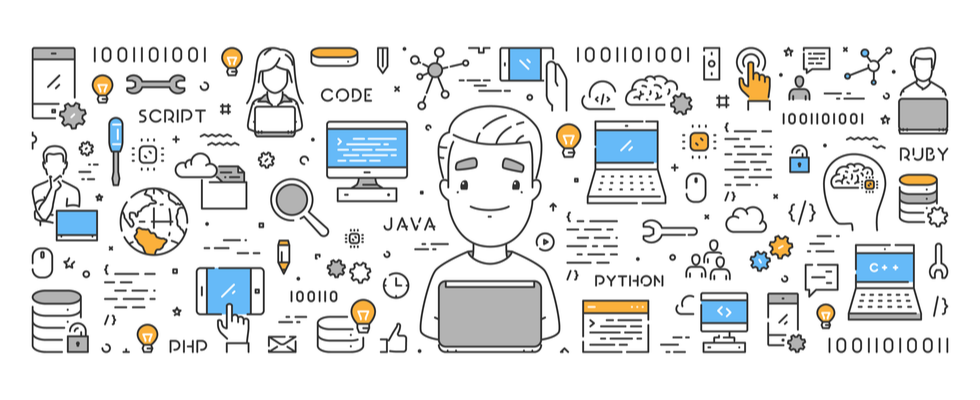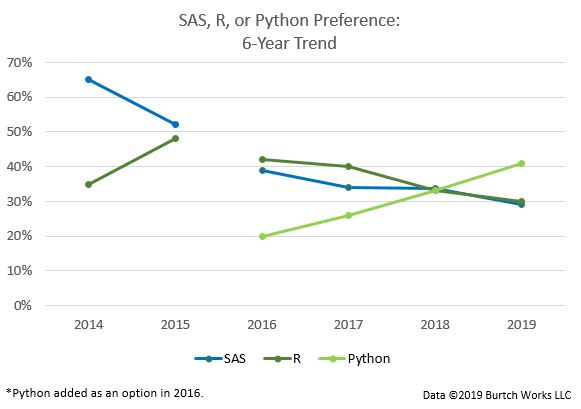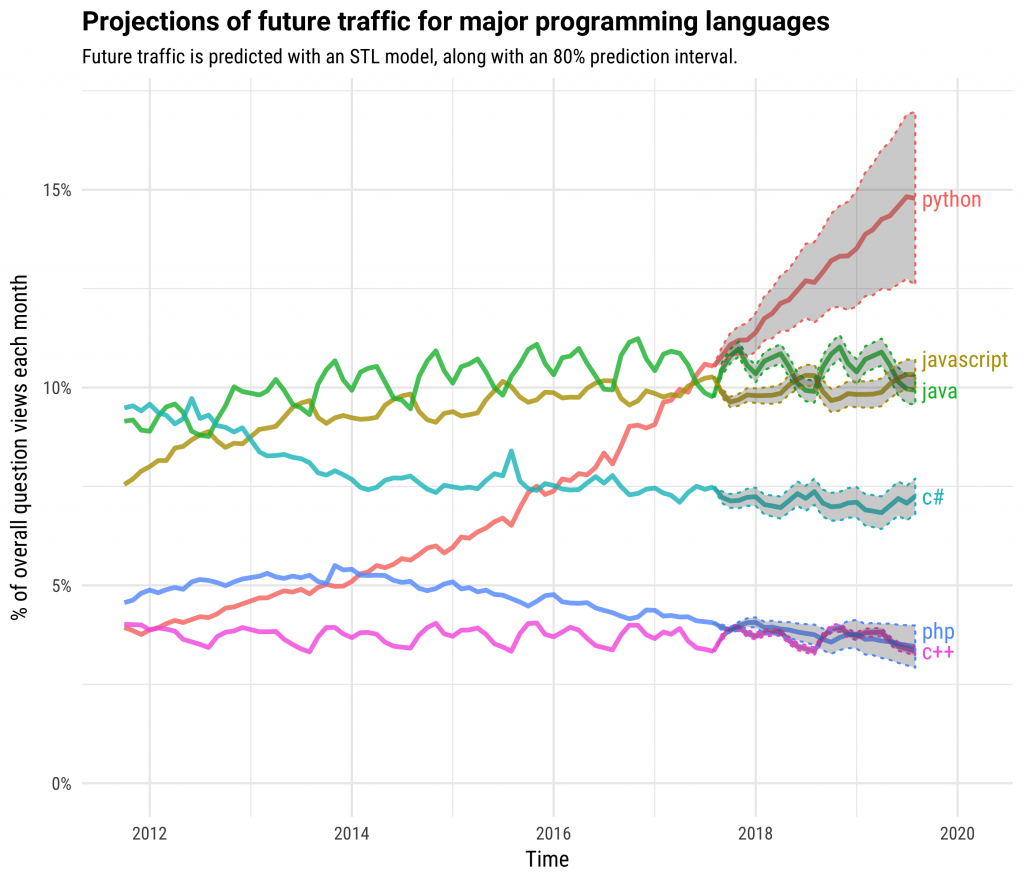Why Is Python So Popular? An Introduction to The World’s Favorite Programming Language

Learn Python, save lives.
Yep, you heard me.
No, I’m not talking about dragging babies from burning buildings or solving tensions in the Middle East. And no, perhaps you won’t win a slew of civic hero awards anytime soon or collect the keys to the city. But there are certainly some compelling reasons why Python is so popular. Among them are some life-saving applications.
In this article, we’ll look at the many and varied uses of Python, the characteristics that make it so incredibly popular, as well as some of the downsides you should be aware of before choosing Python as your new language-learning challenge.
First, though, let’s look at one example that proves Python coders really are just superheroes without capes.
Python’s popularity is growing by leaps and bounds.
Python – Helping Kill Cancer One Pharmaceutical Advance at a Time
Every year, Python comes out on top in surveys of the world's most commonly used programming languages. There are literally thousands of programming languages. Why is Python so popular?
Python’s popularity isn’t something we can unravel by delving headfirst into its syntax. The reasons behind its reputation can be found in the liftoff of a NASA rocket, the safe landing of a passenger jet, or the successful treatment of a sick child. It’s a job hazard for developers to get bogged down in the code and neglect to fully appreciate the everyday applications of their work. So let’s get real, just for a minute.
If you ever, heaven forbid, face cancer or cardiovascular disease, it might just be Python that helps save your life.
AstraZeneca is a major pharmaceutical company with more than 54,000 employees around the world. Its business is creating new drugs that will cure various cancers, heal sick bodies, and tackle cardiovascular, respiratory, and gastrointestinal diseases.
Making even one new medicine is tough. It can take more than ten years and cost over $800 million dollars. One of the biggest hurdles for AstraZeneca scientists is whittling down the list of possible drug candidates to identify potential new medicines. The long list of potential new drugs is overwhelmingly vast, with enough possible molecule combinations to make your head spin.
To save time, AstraZeneca’s experimental chemists now use Python to make computational predictions about useful molecule combinations. Getting a program to filter possible drug candidates based on their known characteristics and effects saves time and money. It means the pharmaceutical company can bring life-saving treatments to patients more quickly.
Not only does Python make advances in pharmaceutical science speedier and more efficient, it also puts the power into the hands of the scientists themselves. Thanks to Python’s simple, user-friendly syntax, programming is no longer solely in the realm of programmers.
Using Python can be fun, even for programming beginners. We’d expect nothing less of a language named after the cult comedy Monty Python’s Flying Circus. Fun fact: Python documentation is littered with Monty Python references – so if you’re a fan, that’s one more reason to get learning Python today!
What Exactly Is Python?
If you haven’t delved into the world of programming languages before, it can all seem a bit overwhelming. But never fear. I have two nuggets of good news for you:
- Python is simple, user-friendly, and easy to learn for programming beginners.
- Vertabelo has a fun, inexpensive Python Basics Course that can get you started and striking out on your own in the Python development world!
In short, Python is a powerful language with a clear and simple syntax. It was created by Dutch programmer Guido van Rossum, who first conceived the language in the late 1980s during some dull moments in his Christmas break. Personally, I’d have used the time to chow down on mashed potatoes and Christmas cake, but each to their own.
It’s a good thing Van Rossum did a little more with his Christmas holidays. Python is now used around the world – not only for smaller-scale applications, but also by big players like Facebook, Uber, Instagram, Netflix, Dropbox, Reddit, Microsoft, Mozilla, NASA, and a little startup you might know as Google.
Who Uses Python? What Do They Use It For?
Python is everywhere, not just at the Googleplex. It’s one of the most versatile programming languages, with applications too numerous to detail here. To understand why Python is so popular, let’s look at some of the most common fields where it’s employed in and why it has proved so useful.
Web developers
Many developers think of Node.js, Java, or .NET when setting up a web server, but don’t overlook Python if web dev is your thing. There are always criticisms of Python’s run speed, but your experience as a developer can outweigh that slight drop in performance. Python remains the core language for many ‘blue chip’ websites, such as YouTube, PayPal, eBay, and Instagram.
There are two main Python frameworks used by web developers. Django offers a solid, relatively immovable structure – great for novices and for building prototypes that launch quickly and easily. Flask allows its users to decide how to approach the design of their system, which is appreciated by more advanced developers.
Desktop GUI and game developers
Python is great for desktop graphical user interface (GUI) and game development. Just a bit of Python knowledge will let you create a basic game in a couple of days, so your dreams of becoming a game developer may not be as far-fetched as you imagined.
Libraries like PyGame make graphical application development easy; you can even achieve a fairly fast FPS (Frames Per Second). Because Python is interpreted, though, you’ll find high-data games don’t stack up in terms of processing speed. If you need a super-fast FPS and high processing power, Python may not be your best bet for GUI.
Data scientists
Data is the new black, and data scientists are like gold to companies looking to extract insights from the world’s datasets. But why is Python so popular for data science?
Stats show that Python use is skyrocketing among data scientists, who find the language easy to use and efficient at organizing and analyzing data. It comes with rich and robust data science libraries, such as Keras (for deep learning), Pandas (for data organization analysis), and Scikit-learn.
An August 2019 survey by Burtch Works noted a steady rise in Python’s popularity among data scientists, gaining 8 percentage points on R since 2018. If you’re into data and want to jump on the Python express, check out this Vertabelo Python for data science course!

Teachers
If teaching is your dream job but you’ve never been sure where your skills lie, Python might be the break you’re looking for. Thanks to its user-friendly design and simple syntax, Python is one of the most popular computing languages taught to both high school and university students. If you’re learning Python with the goal of teaching it later on, your own learning curve won’t be too steep.
Machine Learning and AI experts
Machine Learning and AI are the hottest gigs around. And Python is powering much of the research and development in the Machine Learning world.
Ruby is a great language for cleaning and wrangling data, but it doesn’t feature the same variety and breadth of machine learning libraries as Python does. Python offers comprehensive Machine Learning packages and great tools for visualizing the results. Libraries like Keras, TensorFlow, and Scikit-learn are well-used by the Python Machine Learning pros.
Why Is Python So Popular? The Pros
According to the PYPL (PopularitY of Programming Language) Index shown below, Python is the most popular programming language:
PYPL PopularitY of Programming Language Index
But why is Python so popular? Let’s examine the pros of this language.
It’s simple
Python’s simple syntax makes it very accessible to beginners. Great news for programming beginners: Python is one of the easiest programming languages to learn because it’s written and read a lot like everyday English.
Here’s an example, inspired by Monty Python:
The first piece of code is written in Java:

Here’s the Python code:
print "Nobody expects the Spanish inquisition"
See the difference in complexity?
Python’s simple syntax emphasizes natural language. Because of this, Python code is faster to write and execute. With just a little code, even novice developers can accomplish a huge amount. A lot of the fiddly details required by other languages, like variables and arguments, are all managed by Python.
The simplicity of Python helps users think more clearly when writing programs. It also makes code maintenance and enhancements easier for others down the line.
It’s easy
Python is easy to organize and analyze. Why is Python so popular for data science in particular? If you come from this background, you may have heard the debates over whether Python or R is the better language for data analysis.
One of the main reasons Python is popular in data science is that its libraries provide much of the functionality analysts need. There are also many extra Python libraries that aid data science work, including Pandas, Matplotlib, NumPy, and SciPy. These help with math, data manipulation, and data visualization, among other things.
Python helps data scientists perform advanced calculations without having to become proficient in a complex, learning-intense programming language.
The awesome Python community
There’s a big, supportive Python community and plenty of guides. Hands down one of the best things about Python is its huge developer community. Because Python has such wide coverage across a number of industries, there’s a huge number of developers working with the language and creating support materials for other users. If you have a problem you can’t seem to solve, there’s probably a fellow Python developer out there who can help.
This sense of community is what makes Python great for those new to programming. There are even groups for specific users to join. For example, PyLadies is a global organization for women and other gender minorities who code (or want to code) in Python.
Because Python has been around for quite some time, guides, tutorials, and documents abound. There are nearly 135,000 projects in the Python Package Index (PyPI) – a repository of tools to help you successfully complete any Python project.
The awesome libraries
Python developers can make use of extensive libraries. Thanks to Python’s popularity, hundreds of different libraries and frameworks have been built up over time. They’re an incredible resource for developers and one of the key reasons for Python’s popularity!
These libraries create an ecosystem that can help with a range of development needs. For example, there’s TensorFlow for deep learning, Pandas for data analysis, Flask and Django for web application development, and NumPy and SciPy for scientific computing.
It’s alive!
Python is a living language, so updates and improvements are frequent. Thanks to its large developer community and the ongoing work of the Python Software Foundation, Python benefits from frequent fixes, updates, and improvements. New releases come out roughly every 6 to 18 months. Plus, developers often issue debugged older versions, so stability is constantly improving.
The most up-to-date stable releases are available from the Python download page. The recommended version is 3.x. While 2.x is still used, as of January 1, 2020 it will no longer be maintained.
It’s IOT
Python has staked its place in the Internet of Things. Small, low-power devices make up the wonderful realm known as the ‘Internet of Things’, and Python has taken its place as one of this realm’s Knights of the Round Table. Platforms like Raspberry Pi let developers create their own devices (e.g. phones and cameras) all powered – you guessed it – by Python.
Why Is Python So Popular? The Cons
Nothing is perfect, Python included. Having said that, most of the downsides associated with Python are pretty minor.
Here are some of the common complaints levelled at Python. We’ll let you decide if they’re deal breakers or not.
Python is slower than other languages. This is one of the main criticisms directed at Python, but this isn’t the only language that has possible speed issues. Perl and Ruby can also have their slow moments, so Python is by no means a dinosaur. Some Python benchmarks are faster than C or C++.
That being said, Python is known for its sometimes-slower performance. But as a user, do you always notice the difference between 0.002 and 0.02 seconds? Probably not. As long as it’s not ridiculously sluggish, end users are unlikely to notice. And if things do seem to slow down too much, horizontal scaling can fix many of Python’s bottlenecks.
- It's weak in the mobile computing world. Python isn’t a bad language for mobile development. But with few businesses using the language in their mobile applications, it’s tricky to find mobile developers well versed in Python.
- Users face design restrictions and runtime errors. Python is a dynamically typed language, so it can have design restrictions that lead to runtime errors. Because of this, Python generally requires more testing time than other languages.
- Python is the ‘baby language’ of the programming world. Some programming snobs have likened Python to a ‘baby language.’ Don’t listen to them! We think this is an elitist view held by people who are angry that they learned a more complicated language. One of Python’s founding principles is that “simple is better than complex.”
Is Python the Best Language for You?
There are good reasons why Python keeps coming out tops in programming polls. Python’s popularity doesn’t look like it will slow any time soon. And with so many uses and such demand across a range of industries, it only makes sense to jump on the Python train and start learning. Is Python the best language for you? That depends on your personal preference and what you’ll be using it for. But with such great readability, huge support libraries, and a lively community, we think Python is hard to beat!
Vertabelo’s Python Basics courses are the perfect way to get up and running with Python. They’re beginner-friendly and full of useful exercises and helpful tips. Take a look at the course outline for Part One here and begin your Python journey today.









